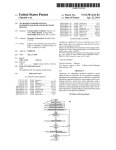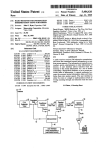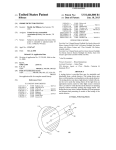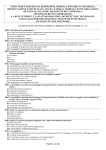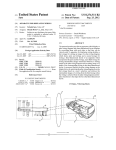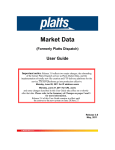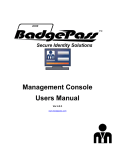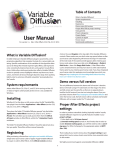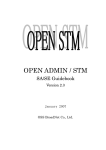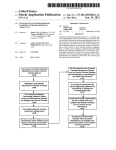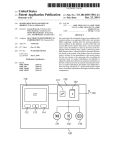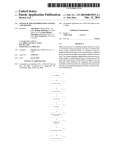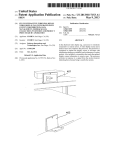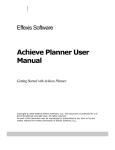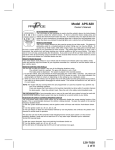Download SERVER Rm
Transcript
US 20120245982A1
(19) United States
(12) Patent Application Publication (10) Pub. No.: US 2012/0245982 A1
Daniel
(54)
(43) Pub. Date:
METHOD AND SYSTEM OF PROVIDING AND
PRESENTING CONTENT TO A USER
_
(75)
Publication Classi?cation
(51)
_
lnvemor'
A‘ Damel’ Potomac Fans’ VA
(52)
Int Cl
G06F 3/048
(2006.01)
G06Q 30/02
(2012.01)
us. Cl. ...................................... .. 705/144; 715/730
(57)
.
_
.
(73) Asslgnee'
Sep. 27, 2012
ABSTRACT
Method of providing and presenting content to a user is dis
Dean Damel’ Potomac Fans’ VA
closed. A user may provide inputs such as categories, topics,
(Us)
key Words; inputs as to quantity, quality, emphasis and/or
inclusion; inputs as to order of presentation, geography or
temporal characteristics. These inputs are used to create a
(21) APP1- NOJ
13/413,395
presentation format. This format is populated With content
using a systemic program and algorithms. The content comes
_
(22)
from various sources. The sources are selected by a secondary
Flledt
Malt 6, 2012
party that is not the user. A user may interact With the presen
tation by skipping, saving, reWinding, indicating like or dis
like or requesting more related content. User interactivity is
Related U.S.Application Data
recorded by the systemic program. The systemic program
records What content has been presented to a speci?c user so
_ _
(60)
_
_
that a subsequent presentation does not repeat content. One
PIOVlSlOnal aPPhCaUOII NO- 61/465,446, ?led 011 Maf-
21, 2011.
result of this method is a personalized neWs and information
radio station.
/103
TERMINAL AT
SOURCE OF AUDIO,
TEXTOR DATA
CONTENT~ NOT REAL
TIME “
/
106
TERMINAL AT
SOU RCE OF
DATA -- REAL
TIME
A
104
101
‘i
v
/
EDITOR
TERMINAL 2
-
V
2‘
)
USER
TERMINAL
READER
TERMINAL 4
=
SERVER ‘HR Rm
105
i—-----—) represents electronic?ows of data
. Content Provision and Presentation System
Patent Application Publication
Sep. 27, 2012 Sheet 1 0f 9
/103
TERMINAL AT
SOURCE OF AUDIO,
TEXTOR DATA
CONTENT- NOT REAL
TIME
US 2012/0245982 A1
/106
TERMINAL AT
SOURCE OF
DATA_ REAL
TIME
AL
104
101
o
w
/
EDITOR
TERMINAL 2
E
r
;‘
’
usER
TERMINAL
READER
TERMINAL {
=
SERVER a “m
105
<—) represents electronicflows of data
Figure 1. Content Provision and Presentation System
Patent Application Publication
Sep. 27, 2012 Sheet 2 0f 9
US 2012/0245982 A1
Patent Application Publication
Sep. 27, 2012 Sheet 3 0f 9
US 2012/0245982 A1
Patent Application Publication
gm
3
M
Sep. 27, 2012 Sheet 4 0f 9
US 2012/0245982 Al
Patent Application Publication
Sep. 27, 2012 Sheet 5 0f 9
US 2012/0245982 A1
Patent Application Publication
Sep. 27, 2012 Sheet 6 0f 9
US 2012/0245982 A1
Patent Application Publication
$3
Sep. 27, 2012 Sheet 7 0f 9
US 2012/0245982 A1
I
I
Patent Application Publication
Sep. 27, 2012 Sheet 8 0f 9
US 2012/0245982 A1
Patent Application Publication
Sep. 27, 2012 Sheet 9 0f 9
US 2012/0245982 A1
Sep. 27, 2012
US 2012/0245982 A1
METHOD AND SYSTEM OF PROVIDING AND
PRESENTING CONTENT TO A USER
FIELD OF THE EMBODIMENTS OF THE
INVENTION
face, alloWs the user to input parameters Which de?ne the
format of the radiocasted content to be received.
[0009] These format parameters include descriptions of the
content; the quantity, quality, emphasis, inclusion and exclu
sion of content; length; geographic focus; and the order of the
[0001] Embodiments of the invention are directed to meth
ods and systems for providing and presenting content to a
content.
user.
Who receives neWs, information and other non-music content
BACKGROUND OF THE EMBODIMENTS OF
THE INVENTION
[0002]
Radio stations present audio neWs, information and
other non-music content in a broadcast format that each lis
tener may not customize or interact With. This “one-size-?ts
all”. presentation of neWs, information and other non-music
content varies in bene?t from individual to individual. A
targeted group of “mainstream” listeners are generally satis
?ed enough to listen to the radio station but the utility of each
listener is not maximized. Many other potential listeners do
not receive enough bene?t from the neWs, information and
non-music content broadcast to Warrant listening at all.
[0003] Improvements in computing technology, availabil
ity of broadband and the rising popularity of streamed media
has created an environment in Which audio streams tailored to
each listener is practical and a groWing expectation.
[0004] The inventor has invented a process by Which the
listener can receive personalized neWs, information and other
non-music content in a radio format Which the listener can
interact With.
[0005]
Our process differs from Patent Application
20030093794 in that our process is not completely automated
as it is in 3794. The method herein alloWs that a secondary
party (i.e. a person) other than the user selects the content
sources and may screen individual content items and may
prioritize content items.
[0006] Discretionary components are added to the method
herein to resolve tWo issues. One, the method described
herein could be used in a commercial operation. Content used
for commercial purposes must be negotiated and paid for.
Automatically extracting content from the universe of media
as described in 3794 for commercial use Would in nearly all
circumstances be illegal. The content into the system
described herein is controlled by a discrete method.
[0007]
TWo, automatically extracting content from avail
able media sources per method 3794 inherently means the
content is second hand neWs and, therefore, is older and less
valuable. Additionally, automatic methods such as described
in 3794 use the placement of the articles on a page or in a
neWscast to determine the signi?cance. The method herein
[0010]
Further enabling the receipt of content is an editor
from a variety of sources and a reader Who Will covert text
content to audio content. The editor Will decide Which content
to make available to the user. Content made available to the
user may be placed into categories like business, sports or
technology, for example. Within a category content items are
prioritized by the editor. Readers Will convert, as necessary,
text content selected by the editor to audio content. Readers
convert text content to audio content in an order Which con
forms to the priority of the content give by the editor. Other
neWs, information and non-music content may be made avail
able to the user Without categorizing or prioritizing by an
editor. For example, stock quotes, Weather data and Internet
posts are made directly available to the user and are converted
to audio content by voice synthesizing softWare. In yet
another example, recorded tra?ic reports acquired from a
third party, the content is already in audio form and does not
require the use of voice synthesizing softWare.
[001 1] Further enabling the receipt of content to the user, an
automated process populates the user’s format based on the
format parameters entered by the user through the Setup
Interface.
[0012] The populated format Will be presented to the user in
a radiocasted presentation.
[0013] The user may interact With an on-going presenta
tion. The user may skip, save, retrieve, reWind, replay, pause,
restart and forWard presentation content. The user may
request additional content related to a content item being
presented or indicate a like or dislike of content.
[0014]
While the presentation is on-going, neW neWs, infor
mation and non-music content may be made available to the
user before the presentation is complete. The remaining por
tion of the on-going presentation Will be adjusted as neces
sary to accommodate neWly available content.
[0015] User interactivity relating to skipping, saving,
retrieving reWinding, replaying, pausing, restarting, forWard
ing, requesting more content, indicating “like” or indicating
“dislike” Will be stored as data. This date Will be used by an
algorithm to alter the priority of items Which have been pri
oritized by the editor. The result is presentation content is
more ?nely tuned to the user’s preferences.
alloWs for the use of content direct from media sources such
as neWsWires, Which has to be judgmentally evaluated for its
signi?cance to determine its priority in a presentation and/or
converted from a text neWsWire form to audio, hence the
manual, discretionary components. As a result, the method
BRIEF DESCRIPTION OF THE DRAWINGS
[0016] For a fuller understanding of the invention, refer
ence is made to the folloWing description, taken in connection
herein can take breaking neWsWire content and include it in a
user’s presentation in a feW minutes and do so before many
With the accompanying draWings, in Which:
sources that method 3794 Would scan even exist.
system.
[0017]
FIG. 1 is a block diagram of the content presentation
viding content to a user is a personalized neWs and informa
[0018] FIG. 2 is an example of a user’s setup interface.
[0019] FIG. 3 is an example of an editor’s selection inter
face, Which enables the editor to exercise discretion as to
including or excluding the neWs article in a database of con
tent that canbe converted to audio and made available for user
tion radio service. This audio service, through a Setup Inter
presentations.
BRIEF SUMMARY OF EMBODIMENTS OF THE
INVENTION
[0008]
One example of our method of presenting and pro
Sep. 27, 2012
US 2012/0245982 A1
[0020]
FIG. 4 is an example of an editor’s graphical inter
face for replacing, adding, deleting, copying, cutting, pasting
[0032] The Setup Interface alloWs the user or user GPS
enabled terminal device to indicate Where the user is located
and prioritizing neWs articles Within categories and subcat
by including a toWn, ZIP code or other location identi?er,
egories.
Which is used by the server When selecting regionally speci?c
[0021] FIG. 5 is an example of an editor’s graphical inter
face shoWing a neWs article’s icon being appended to another
related neWs article’s icon (a side bar article).
[0022] FIG. 6 is an example of a reader’s graphical inter
face for recording text neWs articles into audio ?les.
[0023] FIG. 7 is an example ofa user’s playback interface.
[0024] FIG. 8 is an example of a user’s manual interface.
information like Weather, traf?c and local neWs 207.
[0033] All the input the user enters into the Setup Interface
is stored and processed by the server 102 to create a program
format.
FIG. 9 is an example of a user’s saved interface.
Additional feedback as to hoW much of a particular category
has been requested by the user is provided in a text ?elds 209
DETAILED DESCRIPTION OF EMBODIMENTS
OF THE INVENTION
[0034] The user can adjust and edit the presentation setup.
The user initiates a presentation by activating the NeWs button
208 on the user’s Setup Interface, see example in FIG. 2.
presented for each category shoWn.
[0035]
Multiple user terminals may be connected to the
server 102 at one time.
Setup Interface and Program Format
[0025]
As per example in FIG. 1, the user or users commu
nicate through a terminal 101 or terminals on an electronic
netWork to a server computing device 102.
[0026]
The user creates a presentation format by using a
Accumulating, Editing and Reading NeWs Articles
[0036]
NeWs articles come into the server from neWs Wires
and other providers using a terminal or multiple terminals 1 03
user terminal 101. The Setup Interface is a graphical user
connected to the server 102 by an electronic netWork, see
example in FIG. 1. The terminal can be another server con
trolled by the neWs provider. Some neWs Wire services use
interface. The Setup Inteface alloWs the input of format
procedures Whereby the neWs articles are automatically sent
parameters, Which are communicated over an electronic net
or “pushed”. Other neWs article sources may require that the
neWs articles be manually retrieved or “pulled” by the server
102.
[0037] Each neWs article received and saved by the server
102 is presented on the editor’s terminal 104, Which is con
Setup Interface, see an example in FIG. 2, displayed by the
Work to the server 102 Where the format inputs are stored With
an associated user identi?er.
[0027]
The Setup Interface enables the user to indicate
What categories 201 (e. g. National News, Weather, Headlines,
Tra?ic, Local NeWs, Sports, Entertainment, World NeWs,
nected to the server 102 by an electronic netWork. Each neWs
Business, Lifestyle, Politics, Science in FIG. 2) the user is
interested in. Categories may include national neWs; Weather;
headlines; tra?ic; local neWs; sports; entertainment; World
article presented to an editor is revieWed by the editor, Who
neWs; business; lifestyles, society, people and culture; special
this decision through the editor’s terminal 104 to the server
102. If the editor chooses to delete an article, the server 102
Will delete the article. If not the server 102 Will store and
events, emergency alerts and breaking neWs; science and
technology; tra?ic; postings (e.g. FaceBook), messages (e.g.
TWitter and e-mail) and other topics.
[0028]
The Setup Interface enables the user to indicate the
inclusion of speci?c subcategories 202 (eg ZIP code, City,
Team, Quotes in FIG. 2) the user is interested in. Subcatego
ries may include location, team, sport, genre, entertainer,
business, industry, hobbies, political party, scienti?c ?eld and
other topics.
[0029]
The Setup Interface enables the user to indicate hoW
much of a particular category to include or Whether to exclude
a category. A Quantity button 203 can be clicked and dragged
to extend a bar 204 Which represents the quantity of coverage
requested by the user. As in the example of FIG. 2, the user
could click and drag the sports category Quantity button to a
position that indicates to the server 102 the user Wants to
receive “some” coverage of the category. As in the example of
FIG. 2, the user could click and drag the Weather category
Quantity button to a position that indicates to the server 102 to
exclude Weather information.
[0030] The Setup Interface alloWs the user to indicate in
What order to present categories. For example the user could
determines Whether to delete the article or make it available to
include in a presentation to a user. The editor communicates
manage the article using the methods Which folloW. Each
neWs article is revieWed by the editor using an Editor’s Con
tent Selection Interface, see example in FIG. 3.
[0038] The Editor’s Content Selection Interface includes a
list of articles 301 to consider, Which are identi?ed by source
302, title 303 and Word count 304. The editor selects and
thereby highlights an article to revieW 305. The article
selected to revieW is presented in full 306 in a separate screen
location on the editor’s terminal 104 along With the source
307, title 308 and Word count 309. The text of the article may
be edited. The editor may indicate to the server 102 for the
selected article 306 to be placed on the Editor’s Board, FIG. 4,
by activating a Place button 310. The Editor’s Board is a
graphical interface and representation of a database of articles
organiZed by categories, subcategories and article priority.
The Editor’s Board is maintained by the server 102. The
editor may indicate to the server 102 for the selected article
306 to replace another article on the Editor’s Board by acti
vating a Replace button 311. The editor may indicate to the
server 102 for the selected article 306 to deleted and not added
“click and drag” a category and move it to a different location
to the Editor’s Board by activating a Delete button 312.
on the category list thereby changing the order in Which
categories are presented. Or for example, the user could
renumber the category 205 by entering a neW number and
thus communicate to the server 102 the categories should be
[0039] The editor, through the editors terminal 104, uses
the Editor’s Board, FIG. 4, a graphical interface With the
server 102, to replace, add, delete, copy, cut and paste icons
presented in a neW order.
Headline, World, National, Local, Politics, Business, Sports,
Science, Technology, Celebritology, Entertainment,) and
[0031] The Setup Interface alloWs the user to indicate hoW
long a radiocast should last before recycling the format 206.
401, Which represent articles, into various categories 402 (eg
subcategories 403 (eg individual localities like NeW York
Sep. 27, 2012
US 2012/0245982 A1
City, Los Angeles, Chicago, Philadelphia, Miami, Dallas,
Boston, or Washington; individual political parties, indi
vidual industry segments or businesses, individual sports
count 604. The reader selects and thereby highlights an article
605 from the list 601 to record the article’s audio ?le. The
article selected to be converted into an audio ?le is presented
teams or sports, individual scienti?c ?elds, individual enter
in full 606 at a separate screen location on the reader’s termi
tainment genres, individual celebrities, et cetera).
[0040] The Editor inserts articles onto the Editor’s Board
by “dragging and dropping” an article icon 404 Which
nal 105 along With the source 607, title 608 and Word count
609. The text of the article 606 may be edited. If editing
appears over the Editor’s board after selecting Place 310 or
Replace 311 for an article 306 When using the Editor’s Con
tent Selection Interface, FIG. 3. Where the article is
“dropped” on the Editor’s Board determines Which categories
or subcategories the article belongs in, and also determines
changes the Word count of the presented article 606, the Word
count display 609 Will change to re?ect the current number of
Words that resulted from editing.
[0047] The reader should record on the server 102 through
the reader’s terminal 105 using the Reader’s Interface tWo
the neWs article’s priority among other articles in the same
versions of a neWs article: a longer “article” version and a
category or subcategory.
[0041] The server 102 Will automatically assign a life span
briefer “headline” version. The “article” version is recorded
on the server 102 by activating the Record Article button 610
405 for an article 401 and calculate the expiration time 406.
These times 405, 406 can be edited by clicking on the article
401. The server 102 Will automatically delete the article from
the Editor’s Board and make the article no longer available to
be put in a presentation When the expiration time occurs.
[0042] The editor may also append an article to another
article that is similar in content by “dragging and dropping”
an article icon 501 to the right side of an article already on the
Editor’s Board, see example in FIG. 5. The icon for the
appending article appears over the Editor’s board after select
ing Place 310 or Replace 311 for an article When using the
Editor’s Content Selection Interface, FIG. 5. As in the
example of FIG. 5, an article icon representing an article on
Rand Paul’s criticism of the Federal Reserve is appended to
an article on Federal Reserve Testimony. Doing so Will enable
the user to access the appended article by activating the More
button 708 on the Playback Interface described in methods
beloW. Appended articles are not automatically included in a
user’s presentationithey are the audio equivalent of a maga
Zine article’s side bar.
[0043] Placing the cursor over a speci?c subcategory icon
403 Will reveal the article icons under that subcategory. Plac
ing the cursor over a speci?c article icon 401 Will reveal any
side bar articles Which have been appended to the article icon
401.
[0044] Options to copy, cut, paste and delete an article icon
401 can also be exercised by the Editor through the Editor’s
Board by double clicking on or about an article icon 401 and
selecting the option for copy, cut paste or delete presented on
the Editor’s Board graphical interface.
[0045] Article icons 404, 501 just added to the Editor’s
Board are still in text format only on the server 102 and have
not been converted by a reader into audio format. They appear
a different color on the Editor’s Board from articles Which
have been read into an audio format 401. Article icons on the
Editor’s Board, Which have not been read into audio form
404, 501 are automatically changed in color by the server 102
When the article has been read into an audio ?le by a reader
using the methods described beloW.
[0046] Articles neWly added by an editor to the Editor’s
Board 404, 501 must be converted from text to an audio ?le.
The server 102 communicates these neWly added text articles
to the reader’s terminal 105 through an electronic netWork,
see example in FIG. 1. The reader uses a Reader’s Interface,
see example in FIG. 6, presented on the reader’s terminal 105
to record the conversion of text into an audio ?le. The Read
er’s Interface includes a list 601 of articles presented to the
reader by the server 102. For each article listed 601, the
Reader’s Interface includes the source 602, title 603 and Word
folloWed by the reader reading aloud the article into the
reader’s terminal105. The “headline” version is recorded on
the server 102 by activating the Record Headline button 611
folloWed by the reader reading aloud the article into the
reader’s terminal 105. When the reader is done recording an
“article” version of the selected article 606 or Wishes to pause,
the reader again activates a Record Article button 610. When
the reader is done recording the “headline” version of the
selected article 606 or Wishes to pause, the reader again
activates said Record Headline button 611. If the reader
Wishes to delete the “headline” version of the audio for the
selected 605 article, the reader activates a D.H. button 612. If
the reader Wishes to delete the “article” version of the audio
for the selected 605 article, the reader activates a DA. button
613. If the reader Wishes to hear the current recording of the
article selected 605, the reader activates a Play button 614.
When the reader has completed all recordings for the selected
article 605, the reader activates a Done button 615. Activating
said Done button 615 causes the server 102 to remove the
article 605 from the article list 601 and removes the article’s
text 606 from the Reader’s Interface. Recorded audio ?les are
stored on the server 102 and are available to be included in a
user’s presentation. Information detailing hoW many articles
remain to be read into audio ?les 616 is also presented on the
Reader’s Interface.
Accumulating and Manipulating Other Information Which is
not NeWs Articles
[0048] Information Which becomes quickly outdated (e.g.
temperature, time, and stock quotes) is obtained just before
being streamed as part of the presentation to the user terminal
101. This real-time information is received by the server 102
through an electronic netWork from the information’s source
terminal 1 06. This data, as required by the user’s format input,
FIG. 2, Will be added to user’s presentation by the server 102
utiliZing voice synthesizer technology.
[0049] Information Which does not require reading and is
not required to be obtained in real-time is received by the
server 102 through an electronic netWork from terminals at
the information sources 103 and is stored on the server 102.
This data could include, for example, TWitter messages, audio
traf?c reports provided by third parties or advertisements.
This data Will be stored on the server 102 and, as required by
the user’s format input, FIG. 2, Will be added to a user’s
presentation by the server 102.
[0050] Content from an information source terminal 103,
106 Which is not converted into audio by a reader nor pro
vided in an audio format Will be converted into audio format
Sep. 27, 2012
US 2012/0245982 A1
using a voice synthesizing technology at the server 102. This
late a user’s presentation by ?rst selecting the highest priority
data, for example, could include stock quotes, Weather data
business audio article from the business category of recorded
and e-mail.
audio articles. Then the server 102 Would continue to popu
Starting, Populating and Running a Presentation
business audio article until the total audio time for business
late the presentation With each successively highest priority
[0051]
The user initiates a presentation by activating the
NeWs button 208 on the user’s Setup Interface FIG. 2 pre
sented on the user’s terminal 101. Doing so Will cause the
server 102 to stream an audio logo or other introductory audio
?le to the user’s terminal 1 01. In an alternate embodiment, the
server 102 could cause the user’s terminal 101 to stream an
audio logo or other introductory audio ?le already on the
user’s terminal 101. This audio logo or other introductory ?le
is designed to announce the beginning of the service and
alloW time for the server 102 to populate a presentation With
content and buffer the content stream. Initiating a presenta
tion by activating the neWs button 208 Will also cause the
Setup Interface, FIG. 2, to be replaced by the Playback Inter
face, FIG. 7, on the user’s terminal 101.
[0052] The server 102 already holds audio ?les of neWs
articles Which have been categories, subcategoriZed and pri
oritiZed by the editor and read into audio ?les by a reader as
described in methods detailed previously. The server 102 also
Holds audio ?les provided by third parties such as tra?ic
reports and text such as messages Which can be read by a
voice synthesiZer as described in methods detailed previ
ously.
[0053] When the server 102 receives a presentation request
from a user’s terminal 101, the server 102 Will populate a
presentation in accordance With the user’s format input
recorded on the server 102. The presentation Will be popu
lated With recorded audio (e.g. neWs articles, tra?ic reports);
voice synthesiZed data (eg messages, e-mail) saved on the
server 102; and real-time voice synthesiZed data (eg
Weather, sports scores) retrieved by the server 102 from a
real-time information terminal 106. The categories 402 (eg
World, sports, Weather) selected by the user With the Input
Interface Would be played in the order the user selected during
setup. Articles 401 Within each category Would be played in
the order of priority set by the editor. Real-time information
(e. g. stock quotes, sports scores) is retrieved by the server 102
from a real-time information terminal 106, converted into an
audio ?le With a voice synthesizer and populated into the
presentation just before it is needed in accordance With user
format input. Where presentation time for a category is very
limited, the server 102 Will populate a presentation With
shorter “headline” audio articles instead of full-length audio
neWs articles approximated 8 minutes. Next the server Would
continue to populate the user’s presentation by selecting from
the sports category the highest priority sports audio article
and then each successively highest priority sports audio
article until the total audio time for sports neWs articles
approximated 8 minutes.
[0055] After the audio ?les and non-real time voice synthe
siZed information has been selected by the server 102 for the
presentation, the presentation is streamed to the user’s termi
nal 101.
[0056] If the server 102 has collected user interactivity data
for the user during past presentations, described by methods
Which folloW, the server 102 Will adjust the priority of the
articles Within their respective categories to re?ect the user’s
interest before selecting articles to populate a presentation.
For example, if the user has recently saved audio articles on
Dell Computers, the server algorithm may adjust the priority
of an audio article on Dell Computers several places higher
Within its category. This, in turn, may result in the Dell Com
puters article being included in the user’s presentation that
otherWise Would not have included the Dell Computer article.
[0057] If the server 102 has stored user input that includes
a subcategory 202 through the Setup Interface, FIG. 2, the
server 102 Will increase the priority of related audio articles
Within the relevant category before selecting articles to popu
late the presentation. For example, if the user selected on the
user Setup Interface to receive “a lot” of sports neWs and
Within that category selected the Washington Redskins sub
category, the server Will increase the priority of audio articles
on the Washington Redskins Within the sports category to
ensure that these Washington Redskins articles are included
Within the sports portion of the presentation.
[0058] NeW neWs articles, information or data may be
received by the server 102 from an information source termi
nal 103, 106 and made available to populate a presentation
after a user’s presentation has been started. In some cases, this
neW content Would have been selected to populate a user’s
on-going audio presentation had it been available at the start
of the presentation. To address this issue, the server 102 Will
periodically repopulate an on-going audio cast. For example,
assume a user’s input includes time for the 5 highest priority
political articles and that three political articles have already
articles to ensure a variety of neWs. Advertisements and audio
been presented to the user. Also assume a neW article on a
bumpers are periodically injected into the presentation by the
server 102.
political scandal has noW been placed at the top of the politics
category by the editor, read into an audio ?le by a reader and
[0054] To illustrate populating a presentation, assume that
the server 102 has recorded from the user Setup Interface,
FIG. 2, that the user Wants a 20 minute presentation. Assume
the on-going presentation by the server 102 Would noW
present the neW political audio ?le as the fourth political
the user has selected to receive “a lot” of business neWs
folloWed by “a lot” of sports neWs. Also assume the server 102
is set to include in any presentation 4 minutes of advertise
ments and audio bumpers for every 20 minutes of presenta
tion time. The server 102 Would allocate the time of 20 min
utes betWeen the advertisements, audio bumpers and the neWs
categories and information items selected by the user during
setup. In this case, 4 minutes Would be allocated to advertise
ments and audio bumpers, 8 minutes Would be allocated for
business neWs and 8 minutes Would be allocated for sports
neWs. Continuing our illustration, the server 102 Would popu
made available for presentation. A periodic repopulating of
article in the on-going presentation. The political article
Which Was previously populated fourth in the presentation
Would noW be the ?fth political article presented. The politi
cal article Which Was previously populated ?fth in the pre
sentation Would no longer be presented at all.
[0059] Historical data on What content has been presented
to speci?c users during presentations is stored on the server
102 and referenced When populating presentations so that
content that has already been heard by a speci?c user is not
populated again by the server 102 during subsequent presen
tations to said speci?c user.
Sep. 27, 2012
US 2012/0245982 A1
Interacting With a Presentation
[0060] The user initiates a presentation by activating a
NeWs button 208 on the user’s Setup Interface FIG. 2 pre
sented on the user’s terminal 101. Initiating a presentation by
activating a NeWs button 208 Will also cause the Setup Inter
replaced the Setup Interface, example in FIG. 2, on the user
terminal 101 by activating a Setup button 802 on the Manual
Interface.
face, FIG. 2, to be replaced by the Playback Interface, FIG. 7,
replaced by the Playback Interface, example in FIG. 7, on the
on the user’s terminal 101.
user terminal 101 by activating a NeWs button 803 on the
[0061]
Manual Interface.
While a presentation is on-going, the user can inter
[0072]
[0073]
The user can cause the Manual Interface to be
The user can cause the Manual Interface to be
act With the server’s 102 presentation though a graphical
[0074]
interface on the user terminal, see example in FIG. 7. When at
the Playback Interface, the user can start, pause or restart a
replaced by the Saved Interface, example in FIG. 9, on the
presentation in progress by activating a Play/Pause button
701.
[0062]
The user can cause the server 102 to skip to the next
article by activating an area Where the next article is
announced 702 or by activating a Skip Article button 709.
[0063]
The user can cause the server 102 to skip to the next
category by activating an area Where the next category is
announced 703.
[0064]
The user can cause the server 102 to save an article
or other audio ?le (e.g. advertisement) currently being pre
sented by activating a Save button 704.
[0065]
The user can cause the Playback Interface to be
replaced by the Manual Interface, see example in FIG. 8, on
the user terminal 101 by activating a NeWs button 705 on the
Playback Interface.
[0066]
The user can indicate positive feedback for an neWs
The user can cause the Manual Interface to be
user terminal 101 by activating a Saved button 804 on the
Manual Interface.
[0075] The Saved Interface, FIG. 9, alloWs the user to
retrieve audio articles or other audio ?les (e.g. advertise
ments) stored on the server 102. Each area containing the
name of a saved audio article or other audio ?le 901, can be
individually activated to cause the server 102 to play back the
associated saved audio ?le. Each separately saved audio
article or other audio ?le has its oWn delete symbol 902 that
can be activated by the user causing the server 102 to delete
the corresponding saved audio article or other audio ?le. Each
separately saved audio article or other audio ?le has its oWn
forWard area 903 that can be activated by the user causing the
server 102 to forWard the corresponding saved audio article to
a preset e-mail address.
[0076] The user can sWitch to the Manual Interface,
example in FIG. 8, from the Saved Interface by activating a
NeWs button 904 on the Saved Interface.
article being presented by activating a Positive Feedback
button 706 or the user can indicate negative feedback for a
neWs article being presented by activating a Negative Feed
back button 707. This information Will be stored at the server
102.
[0067] The user can request articles, Which are related to an
article being presented (i.e. sidebars), be added to the presen
tation by activating a More button 708. This Will tell the server
102 to add to the presentation any neWs articles that Were
appended by the editor to the article currently being pre
sented.
[0068]
The user can cause the server to back up in a pre
sentation by a ?xed amount of time by activating a ReWind
button 709. If the user immediately activates said ReWind
button 709 a second time, the user Will cause the server 102 to
back up to the start of the article currently being presented. If
the user continues to immediately activate said ReWind button
709, the server 102 Will be caused to back up by one article or
information item for each time said ReWind button 709 is
activated.
[0069]
The title of the article currently being presented is
noted in a current article area 710. The category currently
being presented is in a current category area 711.
[0070] The server 102 collects and stores all of the user’s
Playback Interface activity data, Which is used to reprioritiZe
the editor’s prioritiZation of articles Within each category just
prior to the populating process. Doing so specialiZes presen
tations for each unique user.
[0071] The Manual Interface, FIG. 8, alloWs the user to
interact manually With the server 102. Any of several buttons
801 each corresponding to a unique category can be activated
to cause the server 102 to present articles only from the
speci?c category the button represents. Articles from the
requested category Will be presented in the priority set by the
editor and adjusted by the server 1 02 for any collected activity
data.
Presentation Recycling
[0077]
When a presentation concludes, the user may start a
subsequent presentation by activating a Play/Pause button
701 or a NeWs button 208. The subsequent presentation Will
folloW the same setup parameters, populating and presenta
tion procedures as the ?rst presentation except the server 102
Will not alloW articles and other content Which Would be
repetitive to be available to populate a subsequent presenta
tion.
Other
[0078]
While the invention has been described in connec
tion With preferred embodiments, it Will be understood that
modi?cations thereof Within the principles outlined above
Will be evident to those skilled in the art and thus, the inven
tion is not limited to the preferred embodiments but is
intended to encompass such modi?cations.
1. A method of presenting content to a user, comprising:
enabling the user to provide inputs that create a presentation
format and set parameters for a presentation of content.
2. The method of claim 1 Wherein the input can be catego
ries or subcategories or topics or subtopics or key Words or
subject identi?ers.
3. The method of claim 1 Wherein the input can be a
quantity or quality or level of emphasis or inclusion or exclu
sion.
4. The method of claim 1 Wherein the input can be tempo
ral.
5. The method of claim 1 Wherein the input can be a
location.
6. The method of claim 1 Wherein the input can be an
ordering of format items.
7. The method of claim 1, further comprising enabling the
user to modify format and parameter inputs.
Sep. 27, 2012
US 2012/0245982 A1
8. The method of claim 1, further comprising that the
format is systematically populated With available content.
9. The method of claim 8 Where in content is related to
time; Weather; historical, current and projected events; infor
mation and data feeds; opinions, editorials or commentaries;
sports; business; science and technology; lifestyles, society,
people and culture; traf?c; alerts; postings or messages; and
advertisements.
10. The method of claim 8, further comprising that content
is made available or selected or excluded at the discretion of
a secondary party other than the user.
11. The method of claim 8, further comprising that content
availability may be prioritized at the discretion of a secondary
party other than the user such that the availability of content
for systematic population into a presentation is increased or
decreased.
12. The method of claim 11, further comprising that user
23. The method of claim 14, further comprising enabling
the user to request more content related to the content being
presented.
24. The method of claim 14, further comprising enabling
the user to selectively provide feedback about the content
being presented.
25. The method of claim 24, Wherein the feedback is posi
tive or negative feedback.
26. The method of claim 25, further comprising enabling,
While the original population is being presented to the user,
the unpresented part of the presentation may be repopulated
based on changes in available content as in claim 8 and then
presented as in claim 13.
27. The method of claim 14, further comprising enabling
during presentation the recording of data relating to What
content has been presented to speci?c users.
28. The method of claim 8, further enabling that recorded
data relating to What content has been presented to speci?c
the priorities of the secondary party in claim 11 and thus alter
users be used during the systematic population of a users
presentation such that content is not repeated to a speci?c
the content that populates a user’s presentation as in claim 8.
user.
13. The method of claim 8, further comprising that content
availability for systematically populating into a user’s presen
tation may be set to expire automatically at the discretion of a
secondary party other than the user.
14. The method in claim 8, further comprising that the
populated format is presented to the user in the format in
claim 1.
15. The method of claim 14, Where in the presentation is in
audio form.
16. The method of claim 14, Where in the presentation is in
29. The method of claim 14, further comprising enabling a
secondary party on the secondary party’s discretion to inter
inputs like selected topic, subtopics or key Words may adjust
text form.
17. The method of claim 14, Where in the presentation is in
graphical form.
18. The method of claim 14, further comprising enabling
the user to skip content being presented.
19. The method of claim 14, further comprising enabling
the user to reWind or replay content being presented.
20. The method of claim 14, further comprising enabling
the user to forWard content being presented.
21. The method of claim 14, further comprising enabling
the user to pause and/or restart the presentation of content.
rupt a user’s presentation such that discretionary content can
be inserted.
30. The method of claim 18, claim 19, claim 20 and claim
22, further enabling data about skipping, reWinding, replay
ing, forWarding, pausing, restarting, or saving to be collected.
31. The method of claim 30, further comprising enabling
an analysis of collected data to adjust the priorities of the
secondary party in claim 11 and thus alter the content that
populates a user’s presentation as in claim 8 and then pre
sented as in claim 14.
32. The method of claim 1, further comprising the enabling
of saving the input such that the input can be reused for
sub sequent presentations.
33. The method of claim 1, further comprising the enabling
of the user to request a radiocast presentation.
34. The method of claim 33, further comprising that When
presentations are requested, a media ?le on the users terminal
or from the server is streamed introducing the service While
the format is populated from available information and/or
database content as in claim 8 and then buffered for the user.
22. The method of claim 14, further comprising enabling
the user to save and/or retrieve content.
*
*
*
*
*

















